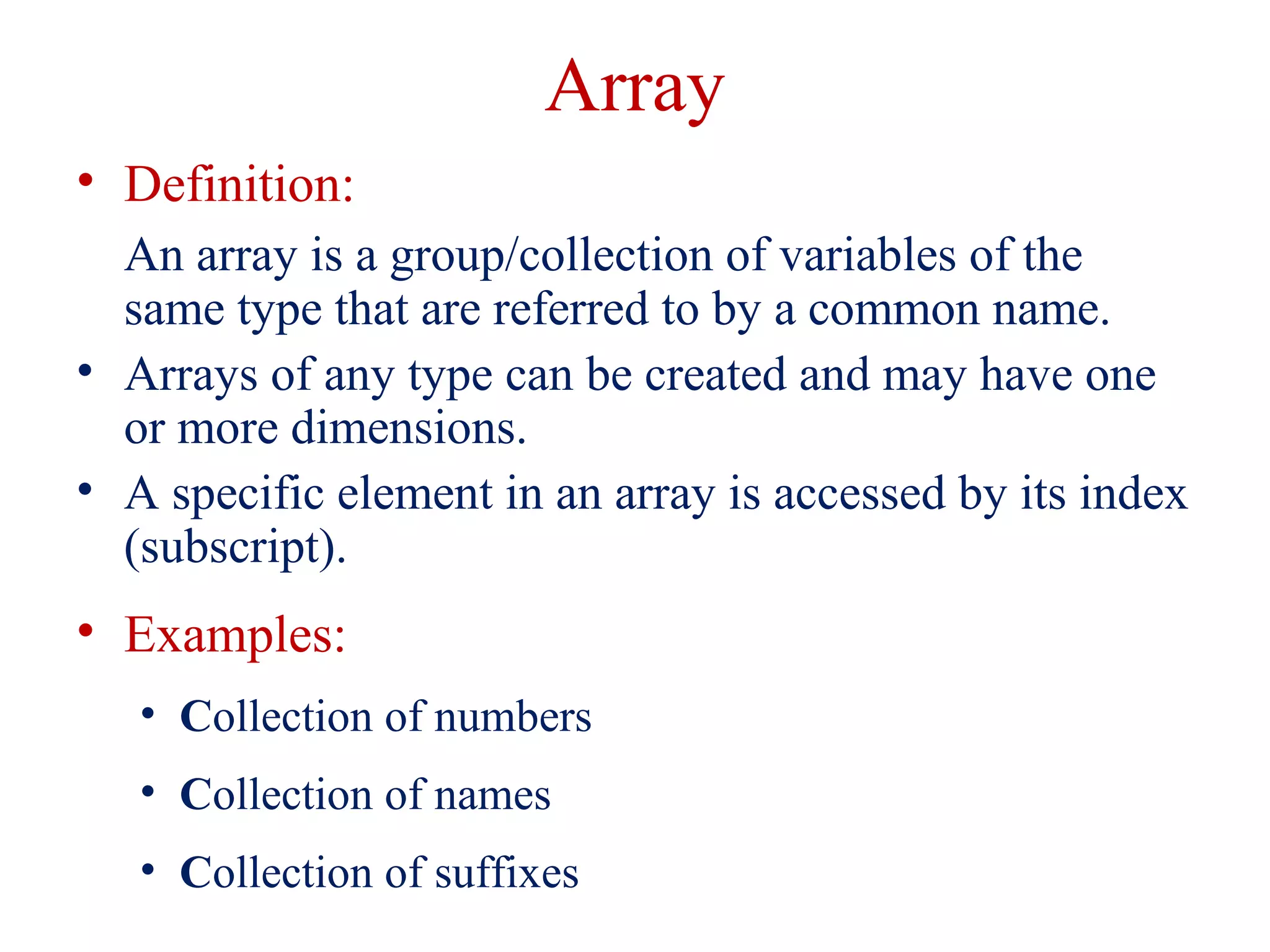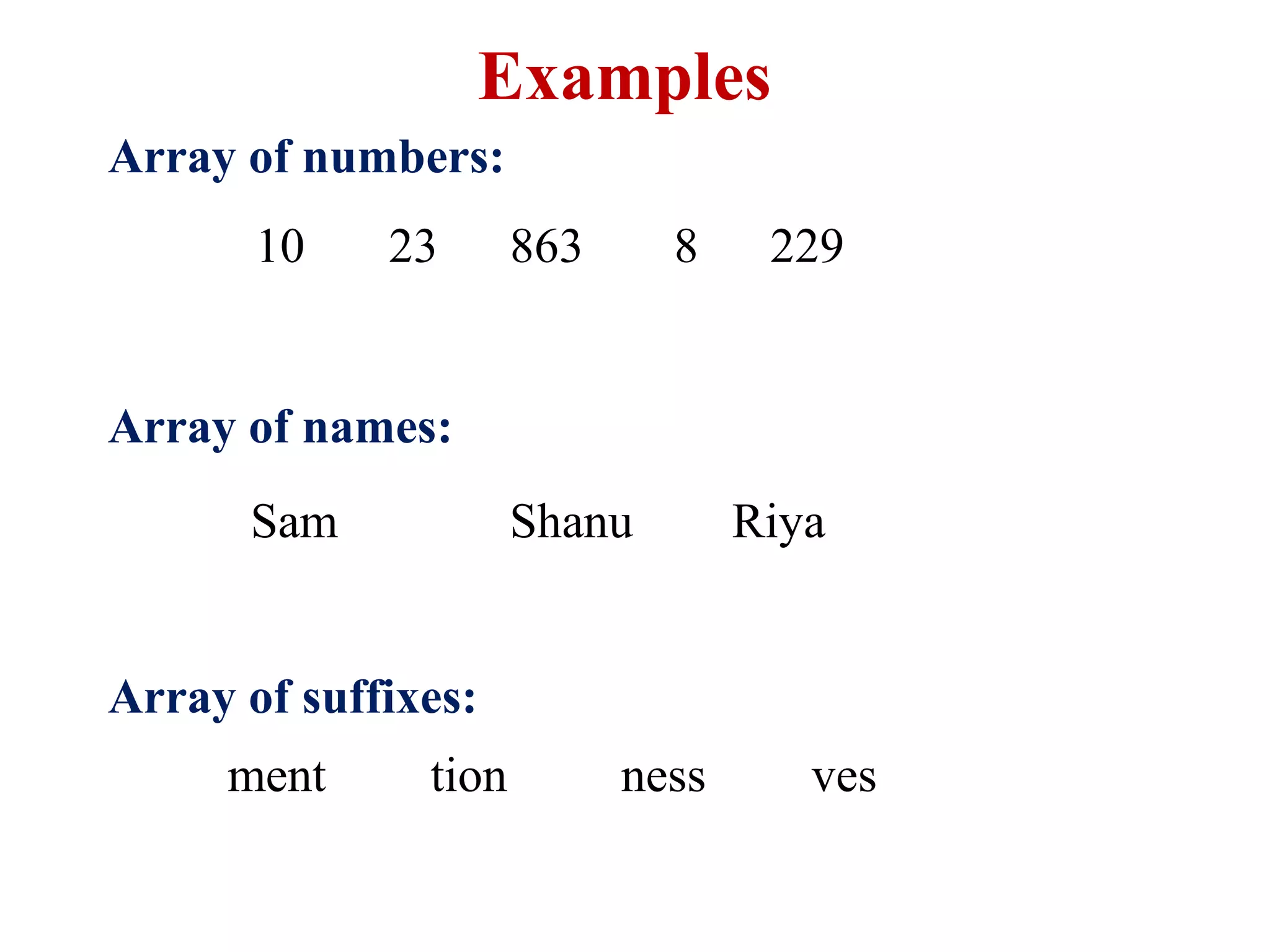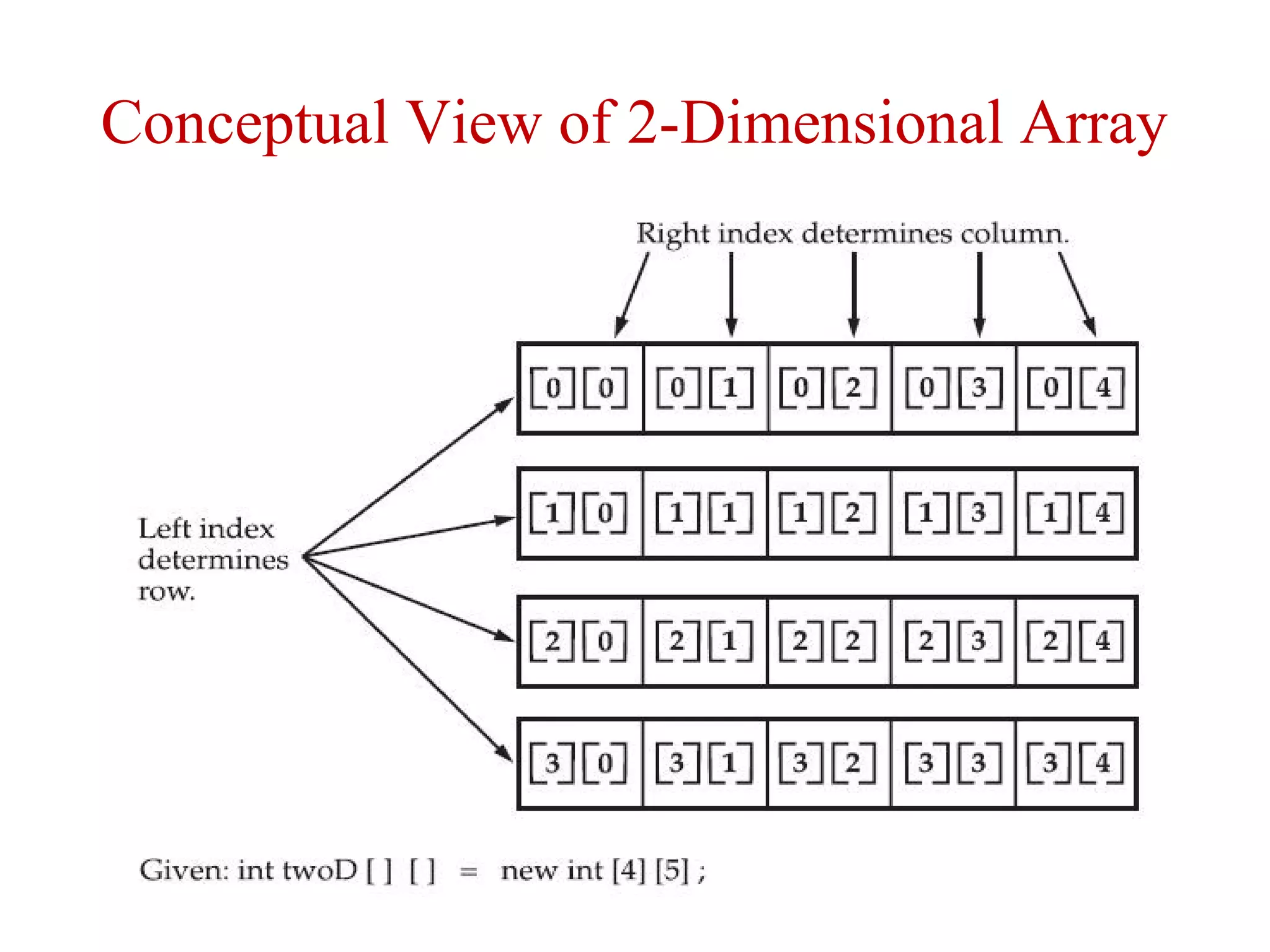This document discusses arrays in Java. It defines an array as a collection of variables of the same type referred to by a common name. Arrays can be one-dimensional or multi-dimensional. Elements in an array are accessed using an index. The document provides examples of declaring, initializing, accessing, and manipulating one-dimensional and two-dimensional arrays in Java. It also discusses passing arrays as arguments and returning arrays from methods.



![One-Dimensional Arrays
• A one-dimensional array is a list of variables of same
type.
• The general form of a one-dimensional array
declaration is:
type var-name[ ]; array-var = new type[size];
or, type var-name[ ] = new type[size];
Example:
int num [] = new int [10];](https://image.slidesharecdn.com/l10-array-150407142937-conversion-gate01/75/L10-array-4-2048.jpg)
![Declaration of array variable:
data-type variable-name[];
eg. int marks[];
This will declare an array named ‘marks’ of type ‘int’. But no memory is
allocated to the array.
Allocation of memory:
variable-name = new data-type[size];
eg. marks = new int[5];
This will allocate memory of 5 integers to the array ‘marks’ and it can store
upto 5 integers in it. ‘new’ is a special operator that allocates memory.
Syntax](https://image.slidesharecdn.com/l10-array-150407142937-conversion-gate01/75/L10-array-5-2048.jpg)
![Accessing elements in the array:
• Specific element in the array is accessed by specifying
name of the array followed the index of the element.
• All array indexes in Java start at zero.
variable-name[index] = value;
Example:
marks[0] = 10;
This will assign the value 10 to the 1st
element in the array.
marks[2] = 863;;
This will assign the value 863 to the 3rd
element in the array.](https://image.slidesharecdn.com/l10-array-150407142937-conversion-gate01/75/L10-array-6-2048.jpg)
![STEP 1 : (Declaration)
int marks[];
marks null
STEP 2: (Memory Allocation)
marks = new int[5];
marks
marks[0] marks[1] marks[2] marks[3] marks[4]
STEP 3: (Accessing Elements)
marks[0] = 10;
marks
marks[0] marks[1] marks[2] marks[3] marks[4]
Example
0 0 0 0 0
10 0 0 0 0](https://image.slidesharecdn.com/l10-array-150407142937-conversion-gate01/75/L10-array-7-2048.jpg)

![Example
class Demo_Array
{
public static void main(String args[])
{
int marks[];
marks = new int[3];
marks[0] = 10;
marks[1] = 35;
marks[2] = 84;
System.out.println(“Marks of 2nd
student=” + marks[1]);
}
}](https://image.slidesharecdn.com/l10-array-150407142937-conversion-gate01/75/L10-array-9-2048.jpg)
![• Arrays can store elements of the same data type. Hence an
int array CAN NOT store an element which is not an int.
• Though an element of a compatible type can be converted
to int and stored into the int array.
eg. marks[2] = (int) 22.5;
This will convert ‘22.5’ into the int part ‘22’ and store it into the 3rd
place
in the int array ‘marks’.
• Array indexes start from zero. Hence ‘marks[index]’ refers
to the (index+1)th
element in the array and ‘marks[size-1]’
refers to last element in the array.
Note](https://image.slidesharecdn.com/l10-array-150407142937-conversion-gate01/75/L10-array-10-2048.jpg)
![Array Initialization
1. data Type [] array_ref_var = {value0, value1, …, value n};
2. data Type [] array_ref_var;
array_ref_var = {value0, value1, …,value n};
3. data Type [] array_ref_var = new data Type [n+1];
array_ref_var [0] = value 0;
array_ref_var [1] = value 1;
…
array_ref_var [n] = value n;](https://image.slidesharecdn.com/l10-array-150407142937-conversion-gate01/75/L10-array-11-2048.jpg)
![Multi-Dimensional Array
• Multidimensional arrays are arrays of arrays.
• Two-Dimensional arrays are used to represent a table or a
matrix.
• Creating Two-Dimensional Array:
int twoD[][] = new int[4][5];](https://image.slidesharecdn.com/l10-array-150407142937-conversion-gate01/75/L10-array-12-2048.jpg)

![class TwoDimArr
{
public static void main(String args[])
{
int twoD[][]= new int[4][5];
int i, j, k = 0;
for(i=0; i<4; i++)
for(j=0; j<5; j++)
{
twoD[i][j] = k;
k++;
}
for(i=0; i<4; i++)
{
for(j=0; j<5; j++)
System.out.print(twoD[i][j] + " ");
System.out.println();
}
}
}](https://image.slidesharecdn.com/l10-array-150407142937-conversion-gate01/75/L10-array-14-2048.jpg)
![• When we allocate memory for a multidimensional
array, we need to only specify the memory for the
first (leftmost) dimension.
int twoD[][] = new int[4][];
• The other dimensions can be assigned manually.](https://image.slidesharecdn.com/l10-array-150407142937-conversion-gate01/75/L10-array-15-2048.jpg)
![// Manually allocate differing size second dimensions.
class TwoDAgain {
public static void main(String args[]) {
int twoD[][] = new int[4][];
twoD[0] = new int[1];
twoD[1] = new int[2];
twoD[2] = new int[3];
twoD[3] = new int[4];
int i, j, k = 0;
for(i=0; i<4; i++)
for(j=0; j<i+1; j++)
{
twoD[i][j] = k;
k++;
}
for(i=0; i<4; i++) {
for(j=0; j<i+1; j++)
System.out.print(twoD[i][j] + " ");
System.out.println();
}
}
}](https://image.slidesharecdn.com/l10-array-150407142937-conversion-gate01/75/L10-array-16-2048.jpg)
![Initializing Multi-Dimensional Array
class Matrix {
public static void main(String args[]) {
double m[][] = {
{ 0*0, 1*0, 2*0, 3*0 },
{ 0*1, 1*1, 2*1, 3*1 },
{ 0*2, 1*2, 2*2, 3*2 },
{ 0*3, 1*3, 2*3, 3*3 }
};
int i, j;
for(i=0; i<4; i++) {
for(j=0; j<4; j++)
System.out.print(m[i][j] + " ");
System.out.println();
}
}
}](https://image.slidesharecdn.com/l10-array-150407142937-conversion-gate01/75/L10-array-17-2048.jpg)
![Alternative Array Declaration
type[ ] var-name;
• Example:
char twod1[][] = new char[3][4];
char[][] twod2 = new char[3][4];
• This alternative declaration form offers convenience
when declaring several arrays at the same time.
• Example: int[] nums, nums2, nums3;](https://image.slidesharecdn.com/l10-array-150407142937-conversion-gate01/75/L10-array-18-2048.jpg)

![Array as Argument
• Arrays can be passed as an argument to any method.
Example:
void show ( int []x) {}
public static void main(String arr[]) {}
void compareArray(int [] a, int [] b ){}](https://image.slidesharecdn.com/l10-array-150407142937-conversion-gate01/75/L10-array-20-2048.jpg)
![Array as a return Type
• Arrays can also be returned as the return type of any
method
Example:
public int [] Result (int roll_No, int marks )](https://image.slidesharecdn.com/l10-array-150407142937-conversion-gate01/75/L10-array-21-2048.jpg)
![Assignment for Practice
• WAP in which use a method to convert all the double
values of argumented array into int.
public int[] double_To_Int(double [] ar)
• WAP to create a jagged Array in which rows and
columns should be taken as input from user.](https://image.slidesharecdn.com/l10-array-150407142937-conversion-gate01/75/L10-array-22-2048.jpg)
